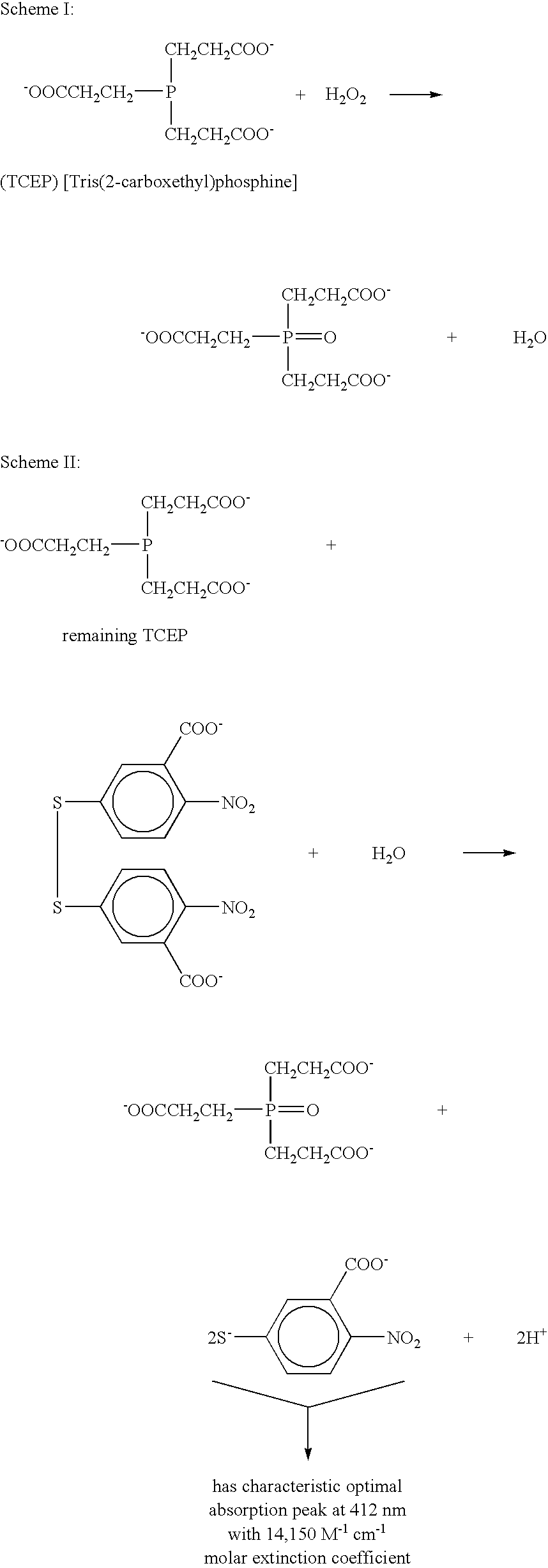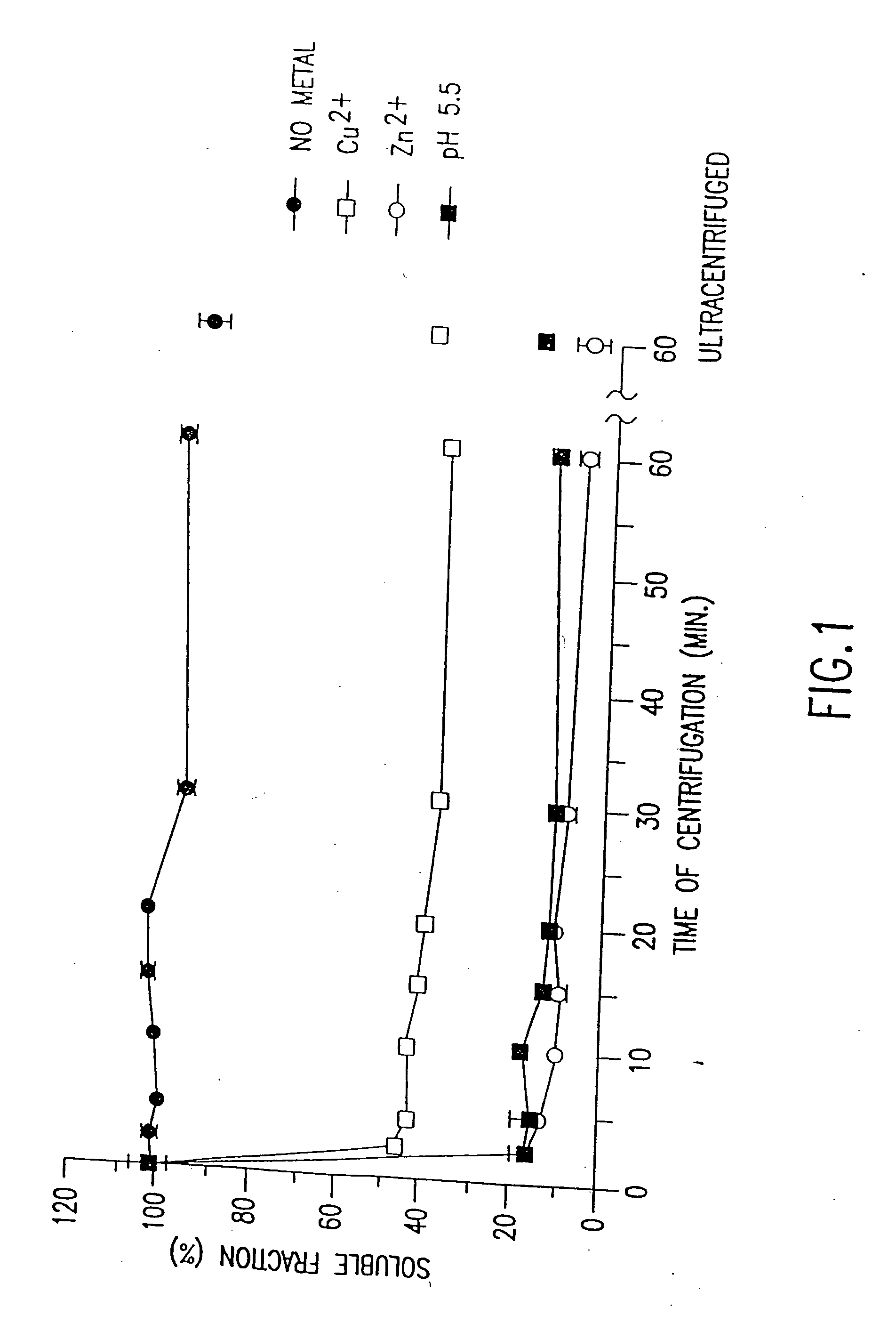Method of screening for drugs useful in treating Alzheimer's disease
- Summary
- Abstract
- Description
- Claims
- Application Information
AI Technical Summary
Benefits of technology
Problems solved by technology
Method used
Image
Examples
example 1
Copper-Induced, pH-Dependent Aggregation of Aβ
Materials and Methods
a) Preparation of Aβ Stock
[0240] Human Aβ1-40 peptide was synthesized, purified and characterized by HPLC analysis, amino acid analysis and mass spectroscopy by the W. M. Keck Foundation Biotechnology Resource Laboratory (Yale University, New Haven, Conn.). Synthetic Aβ peptide solutions were dissolved in trifluoroethanol (30% in Milli-Q water (Millipore Corporation, Milford, Mass.)) or 20 mM HEPES (pH 8.5) at a concentration of 0.5-1.0 g / ml and centrifuged for 20 minutes at 10,000 g. The resulting supernatant (stock Aβ1-40) was used for subsequent aggregation assays on the day of the experiment. The concentration of stock Aβ1-40 was determined by UV spectroscopy at 214 nm or by Micro BCA protein assay (Pierce, Rockford, Ill.). The Micro BCA assay was performed by adding 10 μl of stock Aβ1-40 (or bovine serum albumin standard) to 140 μl of distilled water, and then adding an equal volume of supernatant (150 μl) t...
example 2
Free Radical Formation and SOD-Like Activity of Alzheimer's Aβ Peptides
a) Determination of Cu(I) and Fe(II)
[0270] This method is modified from a protocol assaying serum copper and iron (Landers, J. W. and Zak, B., Chim. Acta. 29:590 (1958)). It is based on the fact that there are optimal visible absorption wavelengths of 483 nm and 535 nm for Cu(I) complexed with bathocuproinedisulfonic (BC) anion and Fe(II) complexed with bathophenanthrolinedisulfonic (BP) anion, respectively. Determining molar absorption of these two complexes was accomplished essentially as follows: an aliquot of 500 μl of each complex (500 μM, in PBS, pH 7.4, with BC and BP ligands in excess) was pipetted into 1 cm-pathlength quartz cuvette, and their absorbencies were measured. Molar absorbencies were determined based on Beer-Lambert's Law. Cu(I)-BC has a molar absorbency of 2762 M−1cm−1, while Fe(II)-BP has a molar absorbency of 7124 M−1 cm−1.
[0271] Determining the equivalent vertical pathlength for Cu(I)-...
example 3
(a) Aβ Activity in a Commonly-Used SOD Assay
[0283] To establish that the anti-superoxide effects of Aβ are evident in vivo, two transgenic mouse lines were studied that express the carboxyl-terminal 100 amino acids of human APP with (mouse line Tg C100.V717F) and without the familial AD (FAD) mutation (mouse line Tg C100.WT) (Li Q. X., et al., J. Neurochem. (1999)). These mice do not display any of the typical neuropathological hallmarks of AD. In addition to overexpressing human Aβ, the Tg C100.V717F mice carry a mutation in the APP gene at residue 717 and consequently produce moderately elevated levels of Aβ1-42 (Suzuki, N., et al., Science 264: 1336-1340 (1994)).
Methods
[0284] Fibroblast cultures. Fibroblasts were harvested from the tails of two Tg C100.WT and two Tg C100.V717F mice. The tissue was minced in 5 ml 0.25% collagenase (w / v) and incubated for 2×30 minutes at 37° C., 5% CO2, with occasional shaking. Following centrifugation for 2 minutes at 1000 g, and 2 washes wit...
PUM
| Property | Measurement | Unit |
|---|---|---|
| Molar density | aaaaa | aaaaa |
| Molar density | aaaaa | aaaaa |
| Time | aaaaa | aaaaa |
Abstract
Description
Claims
Application Information
 Login to View More
Login to View More - R&D
- Intellectual Property
- Life Sciences
- Materials
- Tech Scout
- Unparalleled Data Quality
- Higher Quality Content
- 60% Fewer Hallucinations
Browse by: Latest US Patents, China's latest patents, Technical Efficacy Thesaurus, Application Domain, Technology Topic, Popular Technical Reports.
© 2025 PatSnap. All rights reserved.Legal|Privacy policy|Modern Slavery Act Transparency Statement|Sitemap|About US| Contact US: help@patsnap.com



